A few pictures from my recent pre-survey of the Tigris River ...
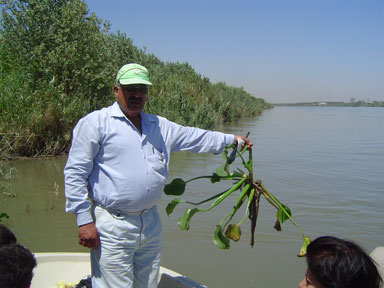
Finally, a picture of the "Nile Flower" (with Samir of the Iraqi Green Peace Organization). This plant grows along the rivers edge in floating mats. It was introduced to the Tigris, I was told, in the early 1980's from Egypt and has become an invasive species. Can anyone help me with its scientific name?
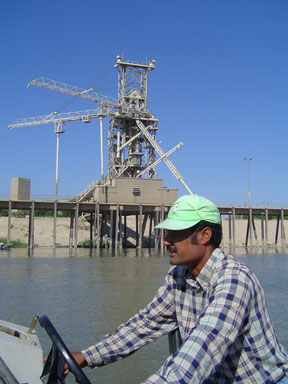
Hamza, the Ali Baba Boatman. Hamza decided halfway down the river that we needed to pay him double the agreed price for the trip. So for 20 minutes we floated down the river as the Iraqis onboard argued with him. We ended up giving him 10,000 ID over the original price (approx. $8 more).
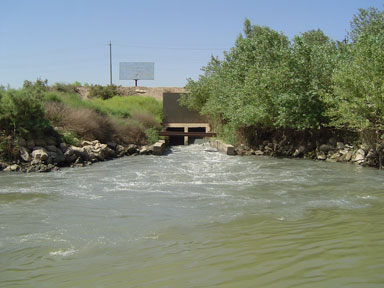
The Khark Sewage Treatment Plant outflow. The western side of the Tigris is generally known as the Khark side. As I understand it, under half of the 5 to 6 million people in Baghdad live on the Khark side and the Khark plant treats their sewage. Actually, at present, only 1/3 of the sewage is being treated at the Khark plant (one of the three plants in the city being rebuilt under contract by Bechtel). This was definitely the untreated part.
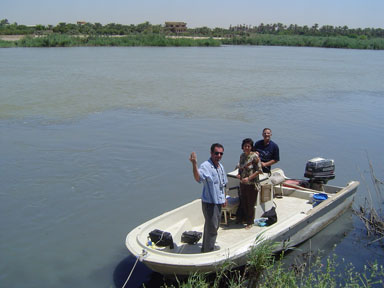
Christian Parenti, Saadia of the Iraqi Human Rights Assoc., and Harb, Christian's translator. We were waiting for our boatman to get fuel ... unfortunately, he had parked us right downstream of the Khark sewage outflow. If you look carefully, you can see the line that divides the sewage water from the river water.
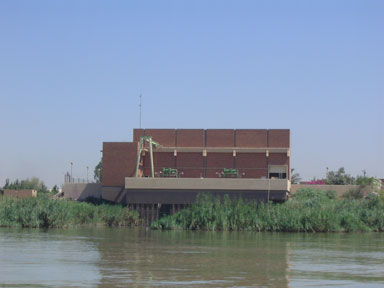
We made the mistake of approaching this Water Treatment plant. I wanted to know what it was called and what area of the city it served. But as we approached, many armed guards suddenly appeared and they were not happy to see us. It was a scary moment but it ended with them passing down a bunch of apples for us and wishing us luck.
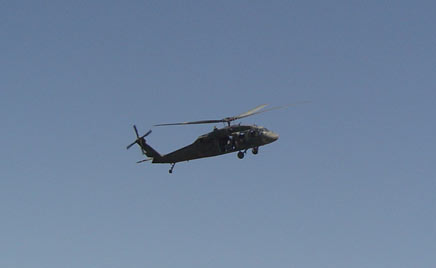
One of the many U.S. helicopter that patrol the city.
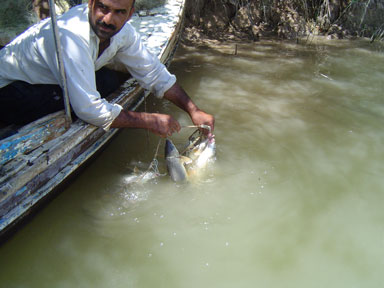
A local fisherman with his catch of fish. The fishing, according to the rivermen we've talked to, has not been good for years.
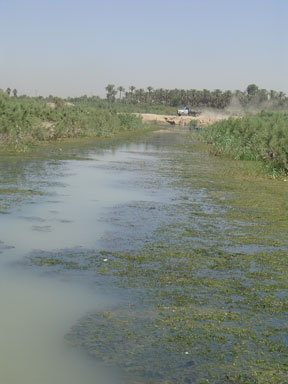
The mouth of the Diyala Tiver that enters the Tigris south of the City, loaded with all the sewage from Rusafa (the eastern bank of the Tigris, where over half of the city's population lives is generally known as Rusafa. It has no functioning sewage treatment at this time.)
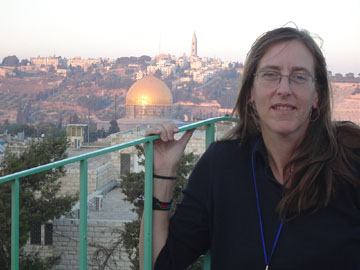
A picture of me ... for Mom!

Finally, a picture of the "Nile Flower" (with Samir of the Iraqi Green Peace Organization). This plant grows along the rivers edge in floating mats. It was introduced to the Tigris, I was told, in the early 1980's from Egypt and has become an invasive species. Can anyone help me with its scientific name?

Hamza, the Ali Baba Boatman. Hamza decided halfway down the river that we needed to pay him double the agreed price for the trip. So for 20 minutes we floated down the river as the Iraqis onboard argued with him. We ended up giving him 10,000 ID over the original price (approx. $8 more).

The Khark Sewage Treatment Plant outflow. The western side of the Tigris is generally known as the Khark side. As I understand it, under half of the 5 to 6 million people in Baghdad live on the Khark side and the Khark plant treats their sewage. Actually, at present, only 1/3 of the sewage is being treated at the Khark plant (one of the three plants in the city being rebuilt under contract by Bechtel). This was definitely the untreated part.

Christian Parenti, Saadia of the Iraqi Human Rights Assoc., and Harb, Christian's translator. We were waiting for our boatman to get fuel ... unfortunately, he had parked us right downstream of the Khark sewage outflow. If you look carefully, you can see the line that divides the sewage water from the river water.

We made the mistake of approaching this Water Treatment plant. I wanted to know what it was called and what area of the city it served. But as we approached, many armed guards suddenly appeared and they were not happy to see us. It was a scary moment but it ended with them passing down a bunch of apples for us and wishing us luck.

One of the many U.S. helicopter that patrol the city.

A local fisherman with his catch of fish. The fishing, according to the rivermen we've talked to, has not been good for years.

The mouth of the Diyala Tiver that enters the Tigris south of the City, loaded with all the sewage from Rusafa (the eastern bank of the Tigris, where over half of the city's population lives is generally known as Rusafa. It has no functioning sewage treatment at this time.)

A picture of me ... for Mom!

0 Comments:
Post a Comment
<< Home